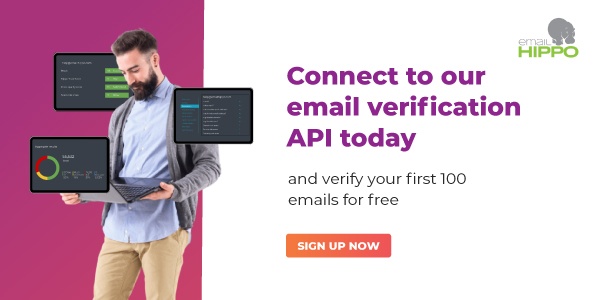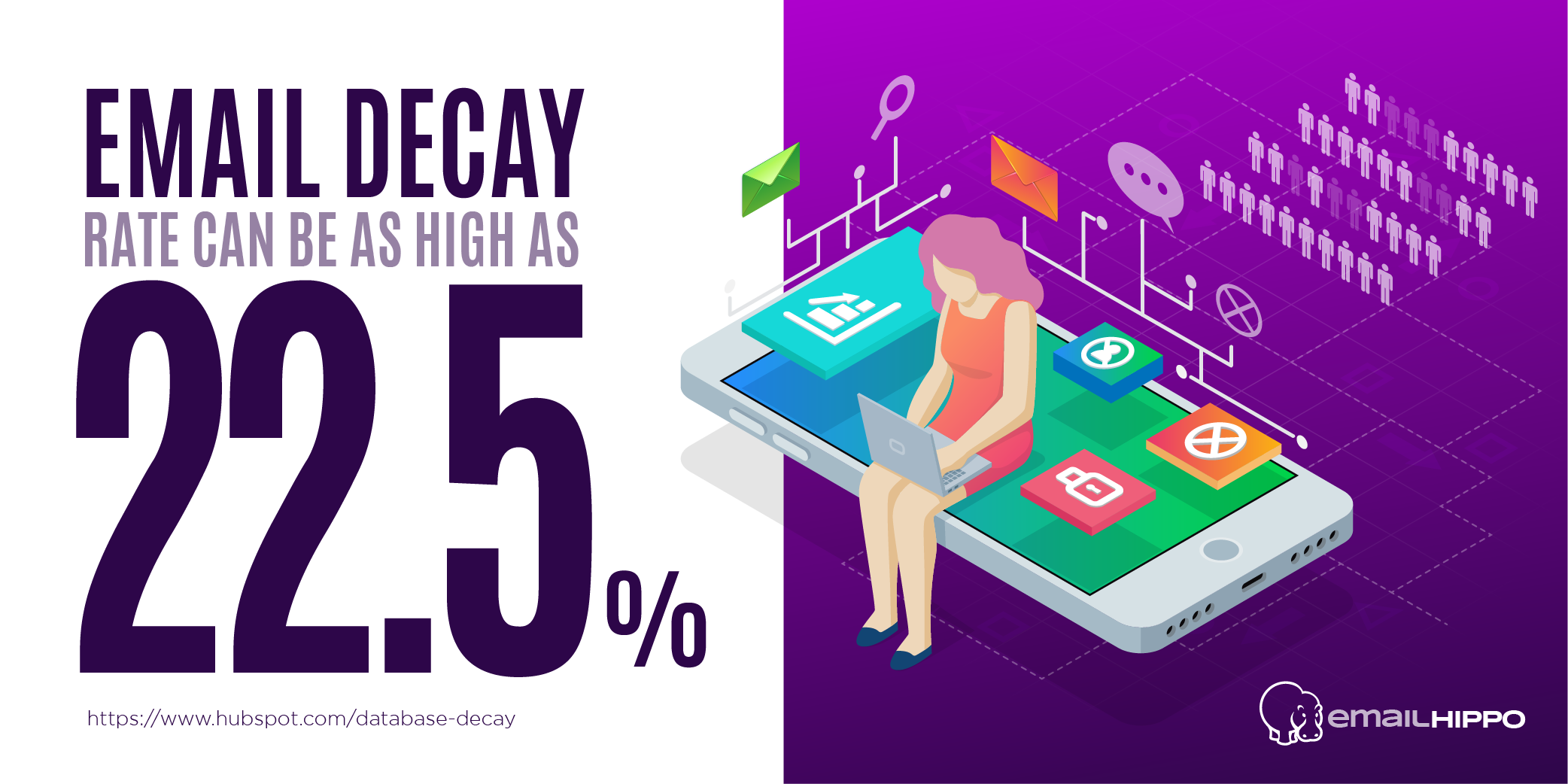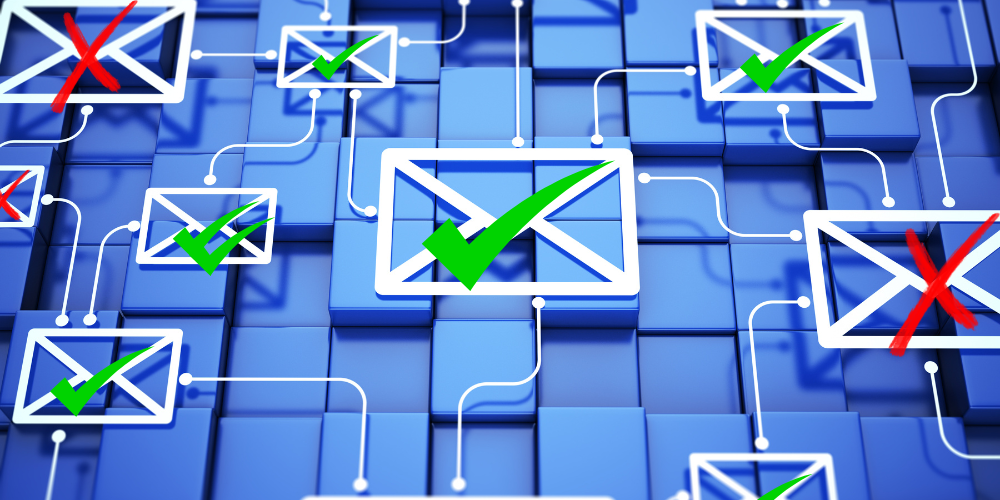How does email verification improve the accuracy of data for data providers?
 Lisa
Lisa

In today's data-driven world, accurate and reliable information is crucial for businesses to make informed decisions and maintain a competitive edge. When it comes to customer data, one key element that often plays a pivotal role is email addresses. However, outdated or incorrect email addresses can lead to significant setbacks, hampering communication efforts and hindering marketing strategies. This is where email validation comes into the picture.
Read on to delve into the realm of email validation and explore its profound impact on data accuracy. In this article, you’ll learn about the importance of data accuracy and how email validation benefits data, as well as learn some of the top email validation best practices and much more.
The importance of data accuracy
Data accuracy is crucial for data providers for several reasons:
- It helps to build and maintain trust in your services. When data is accurate and reliable, your customers can confidently make decisions based on the information you provide.
- Maintaining high email data accuracy helps to build a positive brand reputation and establish yourself as a trustworthy partner.
- It allows you to offer targeted and relevant marketing campaigns to your clients. By maintaining high data accuracy, you can ensure that your clients are reaching the right audience, improving the effectiveness of their marketing efforts.
- By providing accurate email data, you will help your clients to avoid unnecessary expenses and maintain a positive sender reputation.
As a data provider, you strive to offer accurate and reliable email data to your clients. If the email data is incorrect or outdated, it can lead to a poor user experience for your customers. Accuracy ensures that the emails you provide are valid and reach the intended recipients, resulting in better customer satisfaction.
The benefits of email validation for data accuracy
Email validation plays a crucial role in ensuring data accuracy and offers several benefits for data providers and their customers.
These benefits include:
- Improved deliverability - by checking the syntax, domain, and mailbox existence of each email address, data providers can ensure that only valid and deliverable email addresses are included.
- Reduced bounce rate - email validation helps reduce bounce rates by identifying and removing invalid addresses before sending any emails, ensuring that messages are sent only to valid recipients.
- Enhanced data quality - by removing invalid or low-quality email addresses, data providers can maintain a clean and reliable email dataset.
- Improved reputation - Consistently providing accurate and up-to-date email data means you can build a reputation for reliability and trustworthiness.
- Compliance with data regulations - ensuring that email addresses in the dataset are valid and belong to individuals who have provided consent helps you to meet the requirements of regulations like GDPR or CAN-SPAM Act. This helps avoid potential legal issues and penalties associated with non-compliance.
The different types of email validation and how they support data accuracy
.jpg?width=800&height=400&name=pexels-burst-374074%20(3).jpg)
Email validation significantly enhances data accuracy by employing various techniques to verify the validity and deliverability of email addresses. Here's how it improves data accuracy:
Reducing typos and misspellings
During syntax verification, email validation algorithms identify common errors and typos that may occur in email addresses. For example, missing or extra characters, incorrect placements of special characters, or misspelled domain names can be detected.
Filtering out inactive and non-existent email addresses
Email validation verifies the domain of an email address to ensure it corresponds to an active and registered domain. By checking the existence of the domain name and validating its DNS records, email validation can identify invalid or non-existent domains. Email addresses associated with such domains are likely to be inactive or non-deliverable, and they can be filtered out from the dataset.
After domain verification, email validation performs a mailbox existence check. It connects to the mail server associated with the email address and simulates a message delivery to confirm if the mailbox exists and is capable of receiving emails. This step helps identify email addresses that have valid domains but lack active mailboxes. Such addresses are likely to be non-existent or inactive, and they can be filtered out to improve data accuracy.
It's important to note that changes in email validation results can indicate people changing employment, so can be used to indicate which individuals need to be researched to correct their information and who has replaced them.
Removing role-based and disposable email addresses
Role-based email addresses, such as "info@company.com" or "support@website.com," are not associated with specific individuals but rather with specific roles or functions within an organisation. While these addresses can be valid, they may have lower engagement rates or be managed by multiple people. Email validation identifies and flags role-based email addresses, allowing data providers to handle them differently or exclude them based on their specific needs.
Some email addresses are created solely for temporary use or spamming purposes. These are known as disposable email addresses. Email validation also utilises databases and algorithms to identify such disposable or temporary email addresses. These addresses are often associated with a high risk of bouncing or being inactive, so excluding them improves the overall data accuracy.
Minimising spam traps
Email validation systems use various techniques and databases to identify known spam traps or email addresses associated with spamming activities. Spam traps are email addresses that are not actively used by real individuals but are maintained by ISPs, anti-spam organisations, or email blacklist providers to catch and flag unsolicited or suspicious email senders.
Email validation best practices
Email validation is vital for accurate email data, but there are some best practices to follow in order to do it correctly:
Validate your email data regularly
Implement a regular email validation process to ensure the accuracy and cleanliness of your email datasets. Regular validation helps to identify and remove invalid, inactive, or risky email addresses, maintaining data accuracy over time.
Combine multiple validation techniques
Use a combination of syntax checking, domain verification, mailbox existence checks, disposable email detection, and role-based email identification to maximise the accuracy of your email data. Employing multiple validation techniques helps identify a broader range of potential issues and improves overall data accuracy.
Monitor and maintain data quality
Continuously monitor and maintain the quality of your email datasets. Regularly clean your databases, removing invalid or inactive email addresses, and update your records with any changes or opt-outs to keep the data accurate and up to date.
Document validation processes
Document your email validation processes, including the techniques used, tools used, and frequency of validation. This documentation ensures consistency, facilitates auditing, and helps in training new team members on best practices.
Use professional email validation services
Make use of reliable email validation services that provide comprehensive checks for syntax, domain verification, mailbox existence, and other validation techniques. These services can automate the validation process, saving you time and effort while improving data accuracy.
By following these email validation best practices, data providers can ensure the accuracy, deliverability, and effectiveness of their email data, leading to better marketing campaigns, improved customer satisfaction, and stronger business outcomes.
Implementing real-time email validation
Implementing real-time email validation for data providers involves integrating email validation into the data collection process, allowing immediate validation of email addresses as users provide them.
Real-time email validation can be implemented by integrating an email validation API into your data collection system. Most email validation service providers offer APIs that allow you to send email addresses for validation and receive instant validation results in return.
When a user submits an email address through a form or any other data collection method, you need to capture that email address and send a request to the email validation API for validation. The request typically includes the email address to be validated. The email validation API will then process the request and respond with the validation result. The response will indicate whether the email address is valid, invalid, or requires further action, along with additional details such as the reason for validation failure, mailbox existence, and other relevant information.
Real-time email validation APIs are designed to provide fast and accurate results. They utilise various validation techniques, including syntax checking, domain verification, and mailbox existence checks, to deliver reliable validation outcomes in real-time. They typically offer comprehensive documentation and support resources to assist with the integration process. The documentation provides information on API endpoints, request and response formats, error handling, and best practices for integration. Support channels like email, chat, or phone may be available for any technical assistance or inquiries.
By implementing real-time email validation, data providers can ensure that only valid email addresses are collected and entered into their databases. This reduces the inclusion of incorrect or non-existent addresses, enhances data accuracy, and improves the efficiency of marketing campaigns and customer communications.
It’s important to note that when selecting an email validation service provider, you should consider factors such as the reliability of the API, the provider's reputation, data security measures, pricing structure, and any additional features or customisation options that align with your specific needs.
Batch validation for existing databases

Batch email validation is a process where data providers validate a large set of email addresses in bulk, rather than in real-time during data collection. It helps to identify and remove invalid, inactive, or risky email addresses, improving deliverability rates, campaign effectiveness, and overall data quality.
To perform batch email validation, you need to prepare a dataset containing the email addresses you want to validate. This dataset can be in various formats, such as a CSV file, Excel spreadsheet, or a database export. Ensure that the dataset is well-structured, with email addresses in a separate column or field.
The next step is to select an email validation service or provider that offers batch validation capabilities. Look for providers that have experience in handling large-scale email validation and provide accurate results. Once you have chosen an email validation service, you will typically upload your dataset to their platform. The service may have specific guidelines on how to submit the data, such as file format requirements.
The email validation service will then process the submitted dataset, applying various validation techniques to each email address in the batch. These techniques may include syntax checking, domain verification, mailbox existence checks, disposable email detection, and more.
After the validation process is complete, you will receive a report or a downloadable file containing the validation results for each email address in your dataset. The results may include information about the validity of the email addresses, mailbox existence, domain status, and any other relevant details.
Balancing stringency and user experience
Balancing stringency and user experience with email address validation is
important for data providers. While ensuring data accuracy is crucial, it's equally important to maintain a positive user experience for your clients. Here are some considerations to achieve that balance:
Clear and informative validation messages
When implementing email address validation, provide clear and informative error messages to your customers. Instead of simply stating that an email address is invalid, provide specific details on what went wrong. For example, if the email format is incorrect, you can inform your clients about the required format or suggest a correction.
Progressive disclosure of validation requirements
Rather than overwhelming your customers with multiple validation requirements at once, consider employing progressive disclosure. Start with basic validation checks (e.g., email format) and provide additional validation feedback as users move through the data entry process. This approach minimises upfront friction and ensures a smooth user experience.
Optimise validation performance
Implement efficient validation mechanisms to minimise delays and ensure a seamless user experience. Your clients should not experience significant waiting times or performance issues due to email validation processes. Choose email validation solutions that provide fast response times and can handle the volume of requests efficiently.
Integrating email validation into data collection processes
.jpg?width=800&height=400&name=pexels-fauxels-3184339%20(1).jpg)
Integrating email validation into data collection processes involves incorporating validation mechanisms at the point where users provide their email addresses. Here are some common methods for integrating email validation:
Database integration
If you store user data in a database, you can integrate email validation directly into your database operations. Before inserting or updating email addresses in the database, perform validation checks using database triggers, stored procedures, or database-specific validation features.
Content management systems (CMS) or marketing automation tools
If you use a CMS or marketing automation tool, check if they provide built-in email validation features or integrations with email validation services. These platforms may offer plugins, extensions, or modules that can be used to validate email addresses during data collection. For more complex or specific data collection processes, you may need to develop custom solutions to integrate email validation. This can involve creating custom validation components, integrating with APIs, or leveraging existing libraries or frameworks.
Third-party email validation APIs
Third-party email validation APIs allow you to send email addresses for validation and receive validation results in real-time. Depending on the API provider, you may need to make HTTP requests or use SDKs provided by the service to integrate their validation service into your system.
MORE is an email validation API that provides a fast, simple and secure way to validate email addresses in real time. Learn more about our API here.
Email validation and data privacy
Email validation can comply with data privacy regulations when implemented and executed properly. It's crucial for data providers to handle email data in accordance with applicable data privacy laws, such as the General Data Protection Regulation (GDPR) in the European Union or the California Consumer Privacy Act (CCPA) in the United States. Here are some considerations for ensuring compliance:
GDPR compliance considerations
Complying with the General Data Protection Regulation (GDPR) when using email validation requires data providers to handle email data in a manner that respects the rights and protections provided by the regulation.
To comply with GDPR regulations, identify a lawful basis for processing email data under the GDPR. Most commonly, data providers rely on the lawful basis of user consent when validating email addresses. It’s important to ensure that users have provided clear and unambiguous consent to the processing of their email addresses for validation purposes.
You should also provide users with clear and comprehensive privacy notices that explain how their email addresses will be collected, used, and validated. Include information about the purpose of email validation, the types of data processed, the lawful basis for processing, and any third parties involved in the validation process.
If you engage third-party email validation service providers, ensure that you have a data processing agreement (DPA) in place. The DPA should outline the responsibilities of both parties regarding data protection and compliance with the GDPR. Ensure that your service provider is GDPR-compliant and provides sufficient guarantees regarding data security and privacy.
If you transfer email data outside the European Economic Area (EEA), ensure that appropriate safeguards are in place for the lawful transfer of personal data. This may involve relying on approved mechanisms such as Standard Contractual Clauses (SCCs), Binding Corporate Rules (BCRs), or other recognised data transfer mechanisms.
Safeguarding user data
Safeguarding user data is essential for maintaining trust and complying with data protection regulations. Here are some methods you can use to protect user data during email validation:
Data encryption
Implement strong encryption methods to protect user data during transit and storage. Use secure protocols (e.g. SSL/TLS) when transferring data between systems, and encrypt email addresses when storing them in databases or other storage systems.
Access controls
Limit access to email data to authorised personnel only. Implement role-based access controls to ensure that only individuals who need access to the data for validation purposes can retrieve or process it. Regularly review and update access privileges to minimise the risk of unauthorised access.
Secure data storage
Store email data in secure environments, such as secure servers or cloud platforms with strong security measures. Employ industry-standard security practices to protect against data breaches, including firewalls, intrusion detection systems, and regular security audits.
Vendor due diligence
If you engage third-party email validation service providers, conduct due diligence to ensure they have robust data protection measures in place. Assess their security practices, data handling processes, compliance with data protection regulations, and any certifications or audits they have undergone.
Regular security audits and assessments
Conduct regular security audits and assessments to identify any vulnerabilities or weaknesses in your email validation processes. Perform penetration testing, vulnerability scanning, and risk assessments to ensure that your systems and processes are resilient against potential threats.
Ensuring transparent data handling practices
It’s important to inform users about your email validation practices through privacy notices or policies. Be transparent about the purpose of email validation, the data collected, and how it will be used and protected. Provide clear information about users' rights regarding their data, such as the right to access, rectify, or delete their email addresses.
The future of email validation and data accuracy
The future of email validation for data providers is likely to involve advancements in technology and evolving industry practices. By training models on vast datasets, algorithms can learn patterns and identify valid email addresses with higher precision. This can help data providers reduce false positives and false negatives in email validation results.
Another factor in the future of email validation is AI techniques, such as natural language processing (NLP) and predictive analytics. These can be leveraged to enhance email validation processes. AI-powered systems can analyse historical data and user behaviour to predict the validity of email addresses more accurately. These systems can adapt and learn from patterns, ensuring better validation outcomes.
Real-time email validation during the point of data entry will also continue to gain importance. Integrating email validation directly into web forms or data collection interfaces allows for immediate feedback to users, reducing errors and improving data accuracy. It enhances user experience by providing instant validation results without the need for additional steps.
Data providers may also adopt multi-level validation approaches to ensure higher accuracy. This involves employing various validation checks, such as syntax validation, domain verification, SMTP verification, and mailbox existence checks. Combining multiple validation techniques helps minimise errors, detect inactive email addresses, and reduce the risk of delivering emails to invalid or dormant accounts.
It's important to note that these predictions are speculative, and the actual future of email validation for data providers will depend on various factors, including technological advancements, regulatory developments, and industry trends. Data providers should stay informed about emerging technologies and market demands to adapt their email validation practices accordingly.
The benefits of using third-party data sources for email validation

As email marketing becomes an essential tool for businesses to connect with their audiences, it's crucial to ensure the quality of email addresses in your database. That's where third-party data sources for email validation come in handy. By cross-checking with multiple data sources, these tools can detect invalid, fake, or wrongly formatted email addresses quickly and accurately, leading to better inbox deliverability and higher engagement rates.
Beyond that, using third-party data sources for email validation can also protect your brand reputation by avoiding spam traps and reducing the chances of being blacklisted.
Email Hippo’s email validation API solution, MORE, is the ultimate real-time tool for verifying email addresses. It allows you to simply and securely verify email addresses via your marketing platforms, sign-up forms and CRMs. MORE is capable of performing a comprehensive check on every email address entered into the system through automated decisions based on a review of the quality and trustworthiness of your email data.
Don't settle for less. Get more information about the unique benefits of MORE now.
If you’re ready to take the next step with your email verification journey, why not sign up for a free trial?
What To Read Next
.png)



